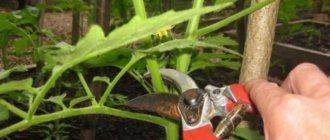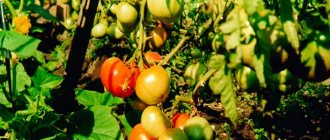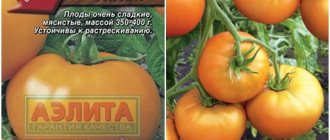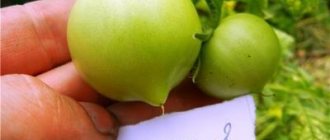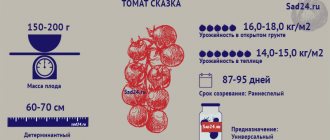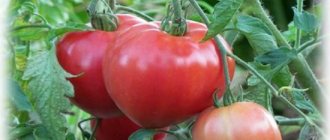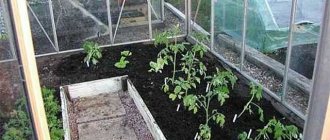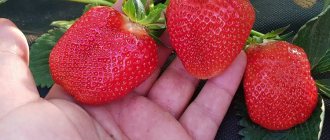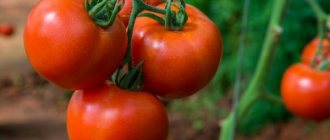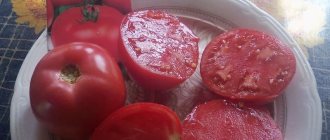Aelita Altai masterpiece is a tomato for cultivation in all regions. Large-fruited, tall and mid-ripening, it provides maximum yield per unit of usable area. Experts recommend growing this variety in garden plots, carefully shaping it and tying it to a trellis.
| Height | Landing location | Ripening time | Fruit color | Fruit size | Origin | Fruit shape |
| Tall | Open ground | Mid-season | Reds | Large | Variety | Flat-round |
Advantages and disadvantages, features, differences from other varieties
Most of the tomato varieties created by the same team as Lentyayka have excellent commercial characteristics and increased resistance to unfavorable conditions.
Lazy Girl was no exception. The main feature of the variety is that even with minimal care you can get good yields of excellent marketable fruits. The main advantages of the variety are:
- large fruit;
- excellent taste;
- the ability of the crop to be transported, stored and ripened;
- high resistance to sudden changes in weather, including prolonged cold;
- compactness of the bush;
- good yield for a short plant;
- ease of care;
- versatility of using tomatoes.
At the same time, capricious gardeners formulated several complaints about the variety:
- the need to tie the stems;
- low heat resistance;
- strong dependence of yield on soil fertility.
It is unlikely that these shortcomings will greatly limit the spread of the variety in domestic gardens, but the warning that it should not be planted in the hottest areas should not be ignored. There are varieties that set fruit at high temperatures, more than 30 ° C: as a rule, they are recommended for the southern regions.
The Lentyayka tomato is part of the line of large-fruited fruits that have been created over the last decade for cultivation in Siberia. In addition to the already mentioned Pudovik, Velmozhi and Heavyweight of Siberia, to some extent, an analogue of the variety can be considered, for example, Miracle of the Earth, which has a similar fruit shape. In terms of taste, it is no worse than the Babushkin Secret variety of the same authors or the Siberian tomatoes Altai Honey or Raspberry Miracle, although they have a different shape of the fruit. These are all tomatoes characterized by excellent taste and the highest resistance to the vagaries of the weather. Among them there are more or less fruitful ones: the Lentyayka variety is not the best in this regard; its main advantage over its analogues is the simplicity of agricultural technology.
Pudovik, with which Lazy Guy is sometimes compared, is larger and has a different color.
Growing an Altai masterpiece
It is very easy to plant tomatoes from Altai and grow large, delicious fruits from them. Usually they are planted as seedlings in a greenhouse in the northern regions, but they can also be grown in open space, just covered with film. The variety is not afraid of cold weather, winds and frosts.
Seeds begin to germinate in early spring, planting them in special containers at home. Caring begins from this time. To germinate them, you need to provide a lot of water, light and heat. Next, the already hatched seedlings are separated and sometimes ventilated, preparing for planting outside.
Around May, already strong seedlings with thick stems are planted in the garden. The distance between seedlings should be about 40 centimeters. Form into 1-2 stems to improve fruiting, and immediately tie to a support. Periodically it is necessary to remove excess shoots - stepchildren. During the growing process, careful care and attention is required: fertilizing, watering, loosening the soil, ventilation, control over the level of moisture and acidity. Then the variety will bear good fruit.
Varieties of the Masterpiece tomato variety, its description and yield
Tomatoes have long occupied pride of place on the tables and beds of vegetable growers and consumers. Masterpiece tomatoes appeared thanks to the efforts of Russian breeders. Positive reviews have secured the tomato’s place among the sought-after plants for beginners and experienced gardeners.
General information about tomato
Today there are several types of Masterpiece tomato:
- An early masterpiece;
- Altai masterpiece;
- hybrid, masterpiece
The first one is preferably grown in temperate and warm climate zones. The plant is suitable for cultivation in open ground and greenhouses. General characteristics:
- mid-season variety, berry ripening time up to 120 days;
- high yield, up to 5 kilograms of berries per bush over the summer;
- short, height does not exceed 50 cm;
- medium foliage;
- leaves are small, dark green;
- the number of fruits in a brush is up to 6 pieces;
- resistance to many nightshade diseases;
- Long-term storage and transportation is possible.
The ripe berry has a sweet taste and an average weight of 120 grams. It is among the universal ones for use. Suitable for canning, pickling and fresh consumption.
The Altai species is also mid-season. Distinctive features include:
- tall, bush height up to 2 meters;
- cold-resistant;
- high yield, up to 4 kilograms per bush;
- resistance to most diseases;
- simple inflorescences;
- tolerates weather changes well;
- large-fruited, weight of individual berries up to 500 grams.
The variety belongs to the salad species. Ripe berries make an excellent ingredient for vegetable salads and tomato products: juices, pastes, sauces.
The third species, Masterpiece f1, belongs to the late-ripening varieties; in all other characteristics it is similar to the Altai species.
Features of agricultural technology
All varieties of Masterpiece tomatoes prefer the seedling method of planting. You can get healthy seedlings by following a number of rules:
- plant seeds to a depth of 1.5-2 cm;
- after sowing, cover containers with seedlings with film;
- when the first shoots appear, move the plants to a windowsill or to a source of artificial lighting;
- regular watering.
IMPORTANT! Before planting, seedlings must be hardened off. The agricultural technology features of the Masterpiece variety of tomatoes have a number of general rules:
The agricultural technology features of the Masterpiece variety of tomatoes have a number of general rules:
- watering with warm, settled water in the evening or morning as needed;
- fertilizing the soil with complex mineral fertilizer at least 4 times per season;
- loosening the soil;
- regular weeding.
For a low-growing species, experienced gardeners advise installing supports under the branches to obtain a better harvest.
Gardeners' opinions
Good day to all! For residents of the northern regions, I recommend the Masterpiece tomato variety. The plant tolerates cold and extreme weather conditions well. The tomato shows resistance to a large number of nightshade diseases and is unpretentious in care. I didn’t find any cons for myself.
Valentin Yagodkin, 43 years old.
I discovered the Altai Masterpiece tomato. The variety is very persistent and not capricious. Gives a decent harvest in cool, rainy summer conditions. The berry is large, sweet and juicy. An excellent option for salads and pickles.
Arkady Novoselov, 47 years old.
How to grow seedlings
The Altai masterpiece tomato variety is grown through seedlings. The seeds are sown at the end of February, after about 60 days the grown and hardened plants are planted in a permanent place of growth. In order for the crop to grow well and bear fruit, vegetable growers follow the rules of agricultural technology.
Seed preparation
Seed material must be fresh. The grains are purchased in a specialized store or collected independently from your own harvest.
Before sowing, the seeds are placed in a container with salt water for 5–10 minutes (10 g of salt per 1 liter of water). During this time, low-quality grains will float to the surface and are thrown away. Next, suitable seed material is rinsed in clean water and placed for 20–30 minutes in a 1% solution of potassium permanganate, then washed again and sprayed with a growth stimulant, for example, “Kornevin”, “Epin” or “Heteroauxin”.
To make the seeds hatch faster, two days before sowing they are laid out on a damp cotton cloth and covered with it. Place in a dark, cool place. The tissue with seed material is kept moist.
Container and soil
Seeds are planted in wooden boxes or special containers. You can use cut-off juice or milk cartons, but most vegetable growers grow seedlings in peat pellets or cups. To drain excess liquid, several holes are made at the bottom of the containers.
Peat products simplify the process of plant picking. The glass along with the seedlings is transplanted into large containers. The peat gradually becomes limp and dissolves in the soil, and young plants are not damaged or stressed.
To grow strong seedlings, use high-quality soil:
- most vegetable growers buy ready-made soil mixture for seedlings;
- some prepare the soil themselves by mixing garden soil, humus, sand (sawdust) and wood ash in a ratio of 2:1:1:1.
Before use, the finished soil is disinfected - poured generously with boiling water or a 1% solution of potassium permanganate. This will destroy harmful bacteria and pest larvae.
Sowing
The seeds are sown in furrows according to a 3x5 cm pattern. If disposable cups are used, no more than 1-2 grains are planted in one container. The seeds are embedded in the soil to a depth of 1–1.5 cm, sprinkled with a thin layer of earth and sand mixed in equal parts.
In order not to wash away the soil, the soil is carefully sprayed with a sprayer. For humidification, use settled water at room temperature. Next, the container with the seeds is covered with film or transparent glass and placed in a warm, bright place.
Growing and care
When the first shoots appear, the cover is removed and the container is placed on the windowsill on the south side of the house. In order not to injure young shoots, the air temperature and humidity are maintained at the same level.
When the plants grow 3-4 true leaves, they begin to harden the seedlings. Two weeks before transplanting to a permanent place, take it outside or onto a balcony for 2 hours. The time the plants spend in the fresh air is gradually increased. This procedure is carried out so that young plants do not get sick and quickly get used to new conditions.
Disease and pest control
The Altai masterpiece is resistant to fungal diseases. Good immunity allows plants to cope with infection on their own, but if care rules are violated, pathogenic microorganisms can begin to develop on the bushes.
Late blight, a disease that affects bushes, poses a danger to the health of the crop. The infection develops rapidly, spreading from leaves and stems to fruits. As a result, tomatoes develop poorly, become stained, wither and become unfit for consumption.
The cause of root rot (another common disease) is a violation of the watering regime. The roots of the plants begin to rot, fungal spores appear in them, and the bushes die.
- Water plants only with warm water.
- Strengthen plants with mineral fertilizers.
- Remove damaged and diseased shoots in a timely manner.
- Make sure that the soil does not rot.
This variety does not suffer from pest attacks. Despite this, periodically inspect the seedlings for the presence of caterpillar larvae and aphids.
Tatyana Orlova (Vasilidchenko) (candidate of agricultural sciences):
There are tomato varieties that are immune to certain diseases, but there are no tomato varieties that are immune to pests. All of them are damaged by the main insect pests of tomatoes.
Tomato care
Tomatoes of the Altai masterpiece variety are unpretentious in care. By observing regular watering, applying mineral fertilizers and carrying out the formation of the bush, you can easily grow a bountiful harvest.
Watering
During the summer heat, seedlings need to be watered abundantly every 2-3 days. Use settled and not cold water for these purposes.
If you are growing tomatoes indoors, do it early in the morning. Plants planted in the garden bed are watered in the evening, after the heat has subsided.
Not only drought, but also excessive humidity is detrimental to tomatoes. Don't forget to regularly loosen the soil around the plants. By carrying out this procedure, you enrich the root system of plants with oxygen, which contributes to their faster growth.
Feeding
Fertilize the plants four times
The first feeding is as soon as the seedlings take root after transplantation (after 14-16 days). The procedure must be repeated every 2-3 weeks.
You can use both organic substances (banana peels, eggshells, coffee grounds) and ready-made mixtures: ammonium sulfate, calcium nitrate.
Tatyana Orlova (Vasilidchenko) (candidate of agricultural sciences):
Plants absorb nutrients when they have already been converted into simple elements: nitrogen, phosphorus, potassium, etc. Plants do not feed on plant debris in the form of banana peels and coffee grounds, etc. They need to rot and completely decompose. This takes time from 2 to 5 months. Therefore, such fertilizing will not have any effect on the growth and development of tomatoes. And the place for all these plant debris is in the compost heap!
The crop also requires foliar feeding. For this, manganese, calcium nitrate, and boric acid are used. After diluting the mineral in water, the liquid is sprayed onto the plants using a sprayer with good atomization.
During the active growing season, tomatoes are fertilized with calcium nitrate (at the rate of 1 tablespoon of the substance per 5 liters of water).
Bush formation
Care includes the formation of a bush. To stop the growth of the stem of plants, pinch the top.
- For tomatoes growing in greenhouse conditions, 2 main stems are left, which allows you to increase the amount of harvest.
- Tomatoes planted in open ground are grown in 1 stem.
The variety is distinguished by the multiple formation of lateral shoots. Carry out periodic removal of stepchildren.
Try to act carefully so as not to damage the bushes. This procedure will help direct all the plant’s forces to the formation of fruits. Rid bushes of withered and diseased leaves and deformed buds.
Cut off the foliage that grows below the first fruit clusters; the plant will receive enough light for normal development.
Characteristics of tomatoes Riddle
Despite the fact that the yield of the variety is at an average level, it has many other advantages: versatility in the use of fruits, resistance to infections, early ripening. In addition, Riddle tomatoes are shade-tolerant and unpretentious.
Tomato yield Riddle
From the moment the first shoots appear until full ripening, 80 to 90 days pass. In other words, the bushes begin to bear fruit in early June.
The yield of the bushes is average - 1.8-3 kg of fruit can be collected from one plant.
Advice! The already early ripening time of tomatoes can be reduced by removing side shoots.
Area of application of fruits
Tomatoes of the Riddle variety are praised in reviews for the versatility of the fruit. Due to their small size, they can be used for whole-fruit canning for the winter, but fresh tomatoes, which are used for salads, are no less popular.
Due to the fact that the skin of the Riddle variety tomatoes is quite dense, when transporting fruits over long distances they do not crack or wrinkle, maintaining a presentable appearance.
Attention! To keep tomatoes fresh and attractive in appearance for as long as possible, it is recommended to place them in containers with their tails down.
Resistance to diseases and pests
A distinctive feature of the Riddle variety tomatoes, which is often emphasized in reviews, is resistance to typical tomato diseases. This is partly due to the fact that tomatoes have time to ripen before the period when the likelihood of late blight infection is highest. The same applies to other fungal infections.
Early ripening allows you to save on chemical protection products, since this variety gets sick extremely rarely and does not require serious preventive treatments.
Advantages and disadvantages of the variety
The advantages of the Riddle tomato variety include:
- super early ripening;
- attractive presentation - the fruits ripen almost identical in size;
- high transportability;
- pleasant sweet taste (5 points out of 5 according to tasting rating);
- the compactness of the bushes, which makes them easier to care for;
- immunity to diseases typical of tomatoes;
- shade tolerance - fruits ripen normally even in insufficient light;
- unpretentiousness;
- ease of care.
The variety has no obvious deficiencies. Reviews about the Riddle tomato are generally positive.
Care
This variety of tomatoes has a small number of stepsons, but they must be removed in a timely manner. It is not recommended to completely break off the stepson, as it can grow back, so you should leave a small “stump”. The shoots are pinched from the bottom of the plants before the first flowers appear. At the same time, it is necessary to tie up the bushes. As they grow, this procedure must be repeated several times a season. Also, don’t forget to pinch off the tops when the plants stop growing.
“Altai Masterpiece” is not very picky, including the composition of the soil. However, like any plant, it needs minerals for the full development of the ovaries. Tomatoes without fertilizing become weak and painful, and the ovary disappears in the first stages of formation.
Fertilizers must be applied not only to the holes before planting, but throughout the entire growing season of the plants. It is necessary to repeat fertilizing two weeks after planting the seedlings. The next stage of fertilization is carried out at the beginning of flowering, and then during the formation of tomatoes. A guarantee of rapid fruit ripening will be feeding tomatoes with complex mineral fertilizers several times during the entire growth period.
The fruits of this type of tomato are not prone to cracking, and the bush itself is insensitive to late blight. For this reason, the bushes are allowed to be watered well, but not too often. This fact pleases gardeners who do not have enough time to constantly be on their plot.
Plants need to be watered at the root. There is no need to do this during the hottest time of the day; it is better to wait until the evening or early morning. This is necessary so that evaporating water from the soil surface cannot “cook” the tomatoes.
The variety does not particularly need disease prevention, since it has high endurance and resistance to a large number of diseases. But, as with growing other types of plants, you need to follow simple tips:
remove plants from the beds after fruiting is completed; promptly eliminate affected fruits and shoots; pay attention to crop rotation.
Description of the domestic selection tomato Masterpiece and recommendations for growing
The Masterpiece tomato embodied all the dreams of farmers: ease of care, high yield, preservation of excellent taste after transportation. The tomato is suitable for regions with temperate and warm climates for planting in open ground and greenhouses.
Important information about the variety
The plant was bred by Russian breeders specifically for areas where sudden temperature changes are possible within a short time. A decrease in humidity for a short period of time does not affect fruiting - this is one of the significant advantages of tomatoes in the short and dry summer of central Russia. According to the description, Masterpiece F1 has a number of advantages that predetermined its culinary and commercial success.
These include:
- taste of berries;
- optimal composition of microelements and vitamins;
- accelerated maturation;
- compactness;
- versatility of use;
- resistance to major diseases;
- long shelf life.
The variety belongs to the determinate, that is, low-growing type of bush formation. The height of an adult plant reaches a maximum of 0.5 m. Thanks to the narrow crown and small leaves, you can save space in the garden, and especially in the greenhouse. Already 95 days after the seedlings emerge, the first harvest is harvested. This precocity is characteristic of the determinate type grown in greenhouses. In open ground, ripening ends within 4 months. One tomato weighs up to 100 g.
There are several varieties of tomato:
Each of them has its own characteristics, advantages and disadvantages. But they all ripen perfectly after harvesting under normal room temperature, within +20 °C. Tomatoes can be used to prepare salads, sauces, purees and pastes. The berries fit perfectly into glass containers for preservation.
Recommendations for cultivation
The best way to grow tomatoes is from seedlings. Burying the seeds begins after March 15 with pre-treatment with growth-stimulating substances. Although the variety is not large-fruited, it is demanding on the quality of the soil, the amount of water in it, and the presence of nutrients and microelements. The plant responds well to the application of a small amount of superphosphate fertilizers. The main component of fertilizing should be organic materials: humus and turf soil.
general characteristics
The Altai masterpiece tomato variety was bred 10 years ago by Barnaul breeders. They managed to obtain a hybrid that grows well in northern latitudes under conditions of unstable and changeable climate.
Tatyana Orlova (Vasilidchenko) (candidate of agricultural sciences):
The tomato is a tropical plant with a high heat requirement and a long growing season. There are currently no frost-resistant tomato varieties. There may be cold-resistant varieties that can withstand (even briefly) low positive temperatures (up to +5-8).
The originator is the Russian company Demetra-Sibir, which entered the plant into the State Register.
In the north, these tomatoes are planted under film; in southern latitudes, they are grown directly in the garden bed. Bushes also take root well in other regions (in Belarus and Ukraine).
Bushes
This is a tall plant, reaching 2 m in height with proper care. The bush requires mandatory formation.
The brown-green powerful stem reliably holds large fruits. A special feature is the multiple formation of lateral shoots.
Tomato leaves are large and green. Inflorescences are formed after 9-10 main leaves have formed on the stem.
Fruit
Altai masterpiece tomatoes are round, their surface is ribbed. The skin is dense and not prone to cracking.
During the ripening period, the fruits retain an emerald color, which gradually changes to deep red.
The tomatoes are massive, weighing 250-400 g per one. Under favorable weather conditions, vegetables can add up to 500-550 g in weight. Breeders have recorded an official record - a tomato weighing 1 kg.
To ensure that the fruits develop well and ripen evenly, tie up the seedlings.
Productivity
According to the characteristics of the Altai Masterpiece variety, the yield is high: with proper care of tomatoes, they harvest about 10 kg/m².
On one bush in open ground conditions it grows 4-6 kg. Under the film, the yield increases to 7-8 kg.
Application area
Gardeners highlight this variety for its pleasant taste, juiciness and aroma. The pulp contains many useful substances and is characterized by increased sweetness. During prolonged rainy weather, ripened fruits develop a sour note.
Tomatoes are grown on an industrial scale.
Tatyana Orlova (Vasilidchenko) (candidate of agricultural sciences):
For commercial production, tomato varieties must meet a number of conditions. These should be plants that require minimal cultivation costs. That is, plants for growing in open ground should only be determinant. No one in the field will tie up tomatoes located, for example, on an area of 10 hectares. And for greenhouses, varieties with a bush height of only 1.5-1.8 m are also of little interest, because industrial greenhouses have a height at the ridge of up to 4 m. Only indeterminate varieties with a height of more than 2.5 meters are grown there. For commercial production, tomato varieties should not have too large fruits. They have a standard weight of 120-150 g.
Thanks to their excellent taste, beautiful appearance and excellent keeping quality of the fruit, they attract the attention of housewives. Ideal for summer salads and winter preparations
Due to their large size, tomatoes are not suitable for canning in their entirety, but they are successfully used as the main ingredient for making sauces, ketchups and juice. Fresh fruits will be on your table until the end of November.
Resistance to diseases and pests
The variety is resistant to diseases
The description notes that Altai masterpiece tomatoes are resistant to many types of diseases common among nightshade crops.
Tomatoes grown indoors rarely suffer from fungal infections, having stable immunity to pathogenic microorganisms.
Harvesting
The harvest needs to be done 110–120 days after the first tomato sprouts appear, so the ripening period of the fruit directly depends on the timing of planting. Typically, fruit ripening occurs in the first ten days of August and continues until the end of September.
Did you know? The largest tomato was grown in the USA: its weight was 2.9 kilograms.
Tomatoes of this variety ripen directly on the bushes; they do not require ripening. Altai masterpiece is recognized as a salad variety, although it can be used to make juice, sauces, seasonings and purees.
Video: Tomato variety Altai masterpiece
Ripe fruits can be stored in the refrigerator for 10–12 days. By being careful when picking tomato fruits and packing them tightly in boxes, this variety is well transported even over long distances.
Despite the fact that the Altai Masterpiece tomato was developed relatively recently, it has already gained popularity due to its unpretentiousness and excellent taste. Knowing all the intricacies of caring for this variety, you can grow it in your garden and eat it.
I wanted to praise the Altai Masterpiece tomato variety! This is a variety that produces very tasty and beautiful fruits. In addition, the variety is quite productive - from one square meter in the garden you can get up to ten kilograms of tomatoes, and in a greenhouse even more
Each fruit reaches four hundred grams, and can be even larger. Special positive qualities include fairly good resistance to disease, and they also tolerate drops in air temperature quite well (but not frost, of course); this is very important for vegetable growers. In addition, the first harvest can be harvested within 110 days from the moment of germination
The “Altai Masterpiece” variety is grown both in greenhouses and in open ground. Tomatoes are a pleasure to eat fresh, and you can also use them to prepare whatever you want - juice, tomato paste, canned with other vegetables (for example, to make lecho or beet caviar). It is very good that this variety is not a hybrid, and everyone who grows them can collect their own seeds. The disadvantage is probably the rather high growth of the bushes, they reach one and a half meters. And, it is clear that they require a mandatory garter. Some vegetable gardeners don't like the hassle of trellises or stakes.
Tju https://www.bolshoyvopros.ru/questions/1935171-sort-pomidorov-altajskij-shedevr-kakie-otzyvy-kak-vyraschivat.html#answer5764939
Description and characteristics of the variety
The tomato is intended for summer residents and private farms. The bush is of indeterminate type; in open ground it manages to grow up to 100-150 cm. The leaves are large, light, and the inflorescences are simple.
The fruits ripen in 110-115 days. Round, slightly flattened tomatoes with a glossy surface, sugary at the break, are formed on the bush. The juice is securely retained in the pulp, the fruits do not flow when cut.
It’s not for nothing that the tomato is called the champion of large fruit. Individual fruits reach a weight of 1 kg. Average weight - 300-400 g. The tomatoes are very fleshy, multi-lobed. When unripe they are green, with an emerald spot at the stalk, when ripe they are bright red. The taste is good, the purpose is salad.
History of selection and region of growth
The variety was bred at the Demetra-Siberia agricultural company, Barnaul. The application for registration was submitted in 2005, inclusion in the State Register took place in 2007. The tomato is recommended for cultivation in open ground and under temporary film shelters in all climatic zones, but it is especially popular in its homeland - Altai.
Which regions are best to grow in?
The Altai masterpiece sets fruit perfectly under any conditions. It was specially bred for cultivation in areas with unstable weather, difficult for farming. It tolerates low temperatures well. It is grown en masse in Siberia and central Russia. In addition, it was liked by gardeners in Belarus and Ukraine.
Farmer reviews
The Altai masterpiece tomato is gaining more and more popularity among vegetable growers. Summer residents prefer this variety for its impressive list of positive characteristics. Here are just some of the opinions of gardeners.
Svetlana, Rostov: “I’ve been growing tomatoes for about 10 years. One of my favorite tomato varieties is Altai masterpiece. The bushes grow to the ceiling of the greenhouse. Culture does not require much attention. During the entire growing season, the plants never got sick, but I carried out preventive measures against insects several times. There was a lot of harvest. One tomato weighs on average 300–400 g. The fruits are beautiful, as in the photo, and most importantly, delicious.”
Sergey, Odintsovo: “The Altai masterpiece tomato variety was grown through seedlings, then transplanted into a greenhouse. The first fruits appeared at the end of July. There were a lot of vegetables, I didn’t know what to do with them. I gave some of it to the children, and from the rest I made tomato juice for the winter. The whole family liked the variety. Next year I will plant the Altai Masterpiece tomato again.”
Altai variety: advantages and disadvantages
The tomato is characterized by increased productivity - 3-4 kg per bush. The variety demonstrates good performance both in the open garden bed and in protected ground. At the beginning of fruiting, the tomatoes are large, collected in clusters of 2-3 pieces. With the second wave they become smaller, but mature in large groups, 4-5 pieces each.
Other advantages of tomato:
- Excellent taste data. Sweetness and sourness are combined here.
- Skin strength. Tomatoes do not crack during ripening.
- Weather unpretentiousness. The tomato sets a normal harvest even during periods of summer cold weather.
- Powerful stem structure. There is no need to tie the brushes additionally. Gardeners attach only trunks to supports.
- Dining versatility. The fruits are eaten fresh, crushed into sauces or juices. Small specimens from the summer harvest are suitable for whole winter preservation.
- lack of uniformity of fruits;
- the plant needs formation and the correct technology for getting rid of stepsons.
Characteristics and description of the Altai Masterpiece tomato variety, yield
The Altai masterpiece tomato variety comes from Siberia, bred by Siberian breeders. Their features are: stable immunity to many diseases, ease of care, adaptability to any weather conditions. This is a unique variety with a bright taste and aroma; it bears fruit for a long time, starting from the end of August. They are grown for fresh food, making juice, sauces, and adjika for the winter. The variety will also be for sale.
More about the Siberian variety
The Altai masterpiece is a mid-season, large tomato, its fruits ripen three months after germination. Seeds for these tomatoes do not need to be bought every year for planting, but collected from the fruits. Grow in any conditions, in a greenhouse or in an open garden. The description of the variety can be read on the seed packet or on the website.
The bushes are very tall, can grow up to 2 meters. Therefore, it is better to tie them to a support so that they do not fall under the weight of the fruit. The foliage is dense, light green in color. The inflorescences are simple. Thick powerful stem. It is usually formed into one, the ovary is located through three leaves.
The fruits of this variety are juicy and tasty. Bright red color. The variety is considered large. Weight can reach up to 500 grams. The shape is round, flattened at the base, ribbed on the sides. The taste is sweet and sour. From two bushes you can collect more than 10 kilograms. It is mainly grown for fresh cuttings and salads. The juice from it is very useful. It contains more vitamin C than citrus fruits. The skin on tomatoes is dense and does not crack. Normally applies to transportation.
The variety is immune to diseases; they do not need to be treated against fungus and rot with various chemicals.
Reviews from those who planted tomatoes are very positive. Everyone is happy with the merits of the variety and wants to plant it again and again.
Growing an Altai masterpiece
It is very easy to plant tomatoes from Altai and grow large, delicious fruits from them. Usually they are planted as seedlings in a greenhouse in the northern regions, but they can also be grown in open space, just covered with film. The variety is not afraid of cold weather, winds and frosts.
Seeds begin to germinate in early spring, planting them in special containers at home. Caring begins from this time. To germinate them, you need to provide a lot of water, light and heat. Next, the already hatched seedlings are separated and sometimes ventilated, preparing for planting outside.
Around May, already strong seedlings with thick stems are planted in the garden. The distance between seedlings should be about 40 centimeters. Form into 1-2 stems to improve fruiting, and immediately tie to a support. Periodically it is necessary to remove excess shoots - stepchildren. During the growing process, careful care and attention is required: fertilizing, watering, loosening the soil, ventilation, control over the level of moisture and acidity. Then the variety will bear good fruit.
Features of care
The characteristics of the variety make it possible to study what conditions to create for tomatoes so that they delight with an abundant harvest of tasty fruits. One of the features in caring for the Altai masterpiece is that tall bushes must be tied with ropes, pinched periodically, and also have good fertile soil in the garden.
Among simple classic care, it is important to note loosening the soil, hilling, ventilating the greenhouse, additional lighting, fertilizing, watering with warm water, and removing weeds. You also need to make sure that there are no pests on the bushes.
They destroy the crop, preventing the tomatoes from gaining juice and vitamins, and eat the leaves. You should always take preventative measures from them: spraying with special solutions, ventilation, destruction of weeds
You also need to make sure that there are no pests on the bushes. They destroy the crop, preventing the tomatoes from gaining juice and vitamins, and eat the leaves. They always need to take preventive measures: spraying with special solutions, ventilation, destruction of weeds.
There is nothing complicated about caring; it is important to simply do everything efficiently and in a timely manner. The Altai masterpiece tomato variety is perfect for those who dream of growing delicious tomatoes in cold conditions with minimal cost and time
If you carefully study the characteristics of the variety and the details of its care, you can increase the yield and quality of taste. Happy landing!
The Altai Masterpiece tomato variety is perfect for those who dream of growing delicious tomatoes in cold conditions with minimal cost and time. If you carefully study the characteristics of the variety and the details of its care, you can increase the yield and quality of taste. Happy landing!
How to care outdoors
Tomato bushes must be pinched and tied to a support. If necessary, pinch the plants so that 4-5 leaves remain above the topmost inflorescence.
Some gardeners leave one main stem, but the crop grows well if the plants are formed into two or even three stems. For the second shoot, a stepson is left, which grows under the first brush.
To ensure that the tomatoes get more sunlight and air, the leaves on the bushes below the first cluster are removed. To obtain larger fruits, gardeners get rid of small or ugly flowers on the racemes.
The Altai masterpiece variety bears fruit on almost any soil, but for this purpose the rules of crop rotation are followed.
Tomatoes are not grown after potatoes, tomatoes and other nightshades earlier than 3-4 years. This is due to the fact that the soil becomes a potential carrier of infections and pest larvae.
Landing technology
Plants grown in greenhouse conditions form one stem, so they are placed closer to each other - 35-40 cm.
After transplanting into open ground, tomatoes will require some care: let’s look at the main points.
Important! The procedure must be carried out with warm, settled water, since cold liquid can lead to poor development of the tomato root system. Watering should be moderate, since if overwatered, the roots will rot, causing the death of the plant.
Insufficient watering can lead to the formation of weak bushes and unripe fruits.
Watering should be moderate, since if overwatered, the roots will rot, causing the death of the plant. Insufficient watering is fraught with the formation of weak bushes and unripe fruits.
Feeding
If there is an insufficient amount of nutrients, plants may develop poorly, so it is necessary to periodically feed them with both organic and mineral fertilizers.
The first feeding is carried out before the formation of the ovary on the bushes. After applying fertilizers, it should be repeated after a week and a half.
Stepsoning
The pinching procedure is necessary for the Altai masterpiece, as this will help redirect useful elements to the fruits, which will have a positive effect on their ripening time.
The appearance of the first stepsons occurs with the development of the first flower raceme. The first stepson that grows under the brush is usually the strongest - it is left. The remaining stepsons located below the first one must be removed from the bush.
Stepchildren are removed in two ways:
- plucked by hand. To do this, you need to break them off to the side;
- cut with garden shears, which are recommended to be disinfected in potassium permanganate after each procedure to avoid the occurrence and spread of infections.
Soil care
To better retain moisture and heat in the soil, the ground next to the tomato bushes should be covered with a layer of mulch - this will help reduce the number of weeds in the area.
Tying up bushes
Altai Masterpiece tomatoes need staking. This procedure is necessary so that plant damage does not occur under fruit pressure. Also, tying is necessary so that the fruits, falling to the ground, do not get sick with tomato rot.
When tying tomatoes, the following means are used:
- Stakes. Their height should be from 2 to 2.5 meters. A peg is driven in near each bush and a garter is made near the crown of the stem using ribbons, stockings, and strips of fabric.
- Caps. The cap is created from 4 rods and is used for 4 bushes. It needs to be dug in 25 centimeters; the top of the rods is connected with wire.
- Trellis. A wire is pulled between the rods, which are placed at a distance from each other. The distance between the rows of wire should be about 45 centimeters. Bushes are tied to this wire.
- Cells. For each bush you need to make a separate cage from wire or metal. It is dug into the ground 15 centimeters and a plant is tied to it.
Altai masterpiece tomatoes are very resistant to diseases, but they can be affected by the following diseases:
- late blight - can quickly destroy both the plant itself and its fruits;
- tomato rot - appears when the soil is waterlogged. The root collar of the tomato begins to rot, which leads to the death of the entire plant.
Prevention of these diseases is to follow the agricultural technology for growing Altai Masterpiece tomatoes. It is necessary to water the plants correctly, do timely fertilizing and remove diseased bushes from the beds.
Insecticides are usually used against pests. Mechanical collection of insects is also possible.
Description of the tomato variety Miracle of Altai, features of cultivation and care
The Altai Miracle tomato was bred by specialists in the last years of the last century and today the plant is included in the state register of the best breeding achievements. Experts set themselves the goal of creating tomatoes that would be able to produce high yields in the climate of the Siberian regions. Thanks to the efforts of specialists, a variety appeared, called the Miracle of Altai. The description of the variety indicates possible cultivation in greenhouses and open ground conditions. The characteristics of the tomato classify it as an interdeterminate type, that is, the growth of the main stem occurs constantly. In open ground, the height of the bush varies from 1.3 to 1.6 meters. In a greenhouse this value may be slightly higher. Due to its high growth, the plant must be tied up, and the supports must be higher than the height of the main trunks.
The plant has powerful trunks, characterized by good strength and a shade of emerald green foliage. The Altai variety has a good ability to set fruit at low temperatures. The bush can easily withstand the weight of the fruit and does not break, so additional tying of the clusters is not required.
Fruit characteristics
Reviews from gardeners confirm the excellent characteristics of the tomato. The first clusters form large-sized tomatoes, weighing on average from 300 to 350 grams. Greater fruit yield occurs in the second wave. The average weight decreases slightly and ranges from 150 to 200 grams. Unripe tomatoes have a small dark spot near the stalk, which disappears as the fruit ripens.
The fruits are rich red in color and have an oval shape. The vegetable pulp harmoniously combines density with tenderness and juiciness. The taste of the tomato is sweetish with a slight sourness. The number of chambers for seeds is on average from 5 to 7.
When and how does maturation occur?
Miracle of Altai belongs to the mid-season varieties in terms of ripening characteristics. The first fruits are harvested 90 days after the first shoots appear. Fruiting lasts a long time and is distinguished by its full yield. Clusters of tomatoes ripen in waves.
Tomato has a high yield. When grown in greenhouses, there are from 10 to 15 kg of vegetables per 1 m2. One plant bush on average brings from 4 to kg of vegetables. In open ground conditions, the yield is slightly lower, but under good weather conditions it can correspond to the values of greenhouse cultivation.
Advantages and disadvantages
The variety is unusually resistant to low temperatures and environmental factors. The seeds have a high germination rate, which reaches 99.8%, and the seedlings tolerate diving well. The ability to tolerate stress is superior to that of some hybrid varieties. Reviews from gardeners indicate the following advantages of the variety:
- has the ability for continuous growth, which does not stop even with a sharp temperature change;
- regardless of weather conditions, ovaries form;
- good yield indicators when grown not only in a greenhouse, but also in open ground conditions.
Due to such advantages, the variety provides excellent yields regardless of weather vagaries. Reviews from gardeners confirm the versatility of the variety. The ability to ripen in waves facilitates the processing of the crop. The only drawback is the plant's intolerance to waterlogging.
Nuances of cultivation
Growing and caring for the plant does not differ from generally accepted rules. It is recommended to adhere to the following tips:
- seedlings that are at least 2 months old are planted in the ground;
- The planting scheme assumes 3 seedlings per 1 m² for open ground, 4 for greenhouse conditions;
- the plant needs tying and pinching;
- bushes must be provided with sufficient ventilation.
Periodic spraying with preparations, soil disinfection and crop rotation will help rid the plant of pests and traditional tomato diseases. Reviews from gardeners indicate the possibility of obtaining a good harvest with minimal time and effort.
